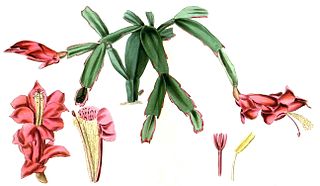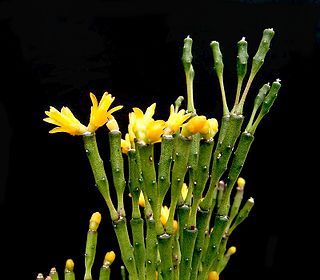
Schlumbergera truncata, the false Christmas cactus, is a species of plant in the family Cactaceae. It is endemic to a small area of the coastal mountains of south-eastern Brazil where its natural habitats are subtropical or tropical moist forests. It is the parent or one of the parents of the houseplants called Christmas cactus, Thanksgiving cactus or zygocactus, among other names.

Schlumbergera is a small genus of cacti with six to nine species found in the coastal mountains of south-eastern Brazil. These plants grow on trees or rocks in habitats that are generally shady with high humidity, and can be quite different in appearance from their desert-dwelling cousins. Most species of Schlumbergera have stems which resemble leaf-like pads joined one to the other and flowers which appear from areoles at the joints and tips of the stems. Two species have cylindrical stems more similar to other cacti.

In 1984, the International Organization for Succulent Plant Study set up a working party, now called the International Cactaceae Systematics Group, to produce a consensus classification of the cactus family, down to the level of genus. Their classification has been used as the basis for systems published since the mid-1990s. Treatments in the 21st century have generally divided the family into around 125–130 genera and 1,400–1,500 species, which are then arranged in a number of tribes and subfamilies. However, subsequent molecular phylogenetic studies have shown that a very high proportion of the higher taxa are not monophyletic, i.e. they do not contain all of the descendants of a common ancestor. As of August 2023, the internal classification of the family Cactaceae remained uncertain and subject to change. A classification incorporating many of the insights from the molecular studies was produced by Nyffeler and Eggli in 2010.

Rhipsalis is a genus of epiphytic flowering plants in the cactus family, typically known as mistletoe cacti. They are found in parts of Central America, the Caribbean and northern regions of South America. They also inhabit isolated locations in Africa and Asia, and are the only cactus group naturally occurring in the Old World. This is the largest and most widely distributed genus of epiphytic cacti.

Rhipsalidopsis is a small genus of flowering plant in the family Cactaceae, native to southern Brazil. Like other members of the tribe Rhipsalideae, its species are epiphytes, growing on trees.

The Cactoideae are the largest subfamily of the cactus family, Cactaceae. Around 80% of cactus species belong to this subfamily. As of August 2018, the internal classification of the family Cactaceae remained uncertain and subject to change. A classification incorporating many of the insights from the molecular studies was produced by Nyffeler and Eggli in 2010. Various revisions have been published since, e.g. to the tribe Hylocereeae and the tribe Echinocereeae. Classifications remained uncertain as of March 2019.

Rhipsalis baccifera, commonly known as the mistletoe cactus, is an epiphytic cactus which originates from Central and South America, the Caribbean, and Florida. It is also found throughout the tropics of Africa and into Sri Lanka where it is known in Sinhala as nawahandi (නවහන්දි). This is the only cactus species naturally occurring outside the Americas. One hypothesis is that it was introduced to the Old World by migratory birds, long enough ago for the Old World populations to be regarded as distinct subspecies. An alternative hypothesis holds that the species initially crossed the Atlantic Ocean on European ships trading between South America and Africa, after which birds may have spread it more widely.

Aporocactus martianus is a species of cactus found in Oaxaca, Mexico.
Schlumbergera kautskyi is a species of plant in the family Cactaceae. It is endemic to a small area of the coastal mountains of south-eastern Brazil where its natural habitat is rocky areas. It is threatened by habitat loss. It is in the same genus as the popular houseplant known as Christmas cactus or Thanksgiving cactus.

Schlumbergera microsphaerica is a species of plant in the family Cactaceae. It is endemic to a limited area of the coastal mountains of south-eastern Brazil where its natural habitat is rocky areas above 2,600 m (8,500 ft). It is threatened by habitat loss. It is in the same genus as the popular house plant known as Christmas cactus or Thanksgiving cactus.

Schlumbergera opuntioides is a species of plant in the family Cactaceae. It is endemic to the coastal mountains of south-eastern Brazil where its natural habitats are humid forests and rocky areas. It is threatened by habitat loss. It is in the same genus as the popular house plant known as Christmas Cactus or Thanksgiving Cactus.

Schlumbergera russelliana is a species of plant in the family Cactaceae. It is endemic to a small area of the coastal mountains of south-eastern Brazil where its natural habitat is moist forest. It grows on trees as an epiphyte. It is one of the parents of many of the popular houseplants known as Christmas cactus or Thanksgiving cactus.

The Rhipsalideae are a small tribe of cacti, comprising four or five genera. They grow on trees (epiphytes) or on rocks (lithophytes), where they either hang down or form creeping or upright shrubs. Their flowers open in the day and remain open at night; they may be either radially symmetrical (regular) or bilaterally symmetrical (zygomorphic). The fruits are berry-like, fleshy with smallish seeds.

Rhipsalidopsis gaertneri, synonyms Schlumbergera gaertneri and Hatiora gaertneri, is a species of epiphytic cactus which belongs to the tribe Rhipsalideae within the subfamily Cactoideae of the Cactaceae. Together with the hybrid with R. rosea, Rhipsalidopsis × graeseri, it is known, in English speaking countries in the Northern Hemisphere, as Easter cactus or Whitsun cactus and is a widely cultivated ornamental plant. It has received the Royal Horticultural Society's Award of Garden Merit.

The Hylocereeae are a tribe of cacti. Most are found in the tropical forests of Central and northern South America, and are climbers or epiphytes, unlike most cacti. The tribe includes between six and eight genera in different circumscriptions. The plants known as "epiphyllum hybrids" or "epiphyllums", widely grown for their flowers, are hybrids of species within this tribe, particularly Disocactus, Pseudorhipsalis and Selenicereus, less often Epiphyllum, in spite of the common name.

Hatiora salicornioides, the bottle cactus, dancing-bones, drunkard's-dream, or spice cactus, is a species of flowering plant in the cactus family. A member of the tribe Rhipsalideae, it often grows as an epiphyte, natively in eastern Brazil and ornamentally elsewhere.

Rhipsalidopsis rosea, synonyms Hatiora rosea and Schlumbergera rosea, is a species of flowering plant in the family Cactaceae, native to south Brazil. It was first described, as Rhipsalis rosea, by Gustaf Lagerheim in 1912. It is one of the parents of the hybrid Rhipsalidopsis × graeseri, grown as the Easter or Whitsun cactus.
Schlumbergera lutea, synonym Hatiora epiphylloides, is a species of flowering plant in the family Cactaceae, subfamily Cactoideae, native to southeast Brazil. It is a shrubby epiphyte, with flattened stems and bright yellow flowers.

Hatiora cylindrica is a species of often epiphytic cactus in the tribe Rhipsalideae within the subfamily Cactoideae. It is native to east Brazil, where it grows in a variety of habitats, including moist forest, dunes and coastal rocks.
Hatiora herminiae is a species of flowering plant in the tribe Rhipsalideae, family Cactaceae. It grows as an epiphyte in cloud forests in Southeast Brazil.
















